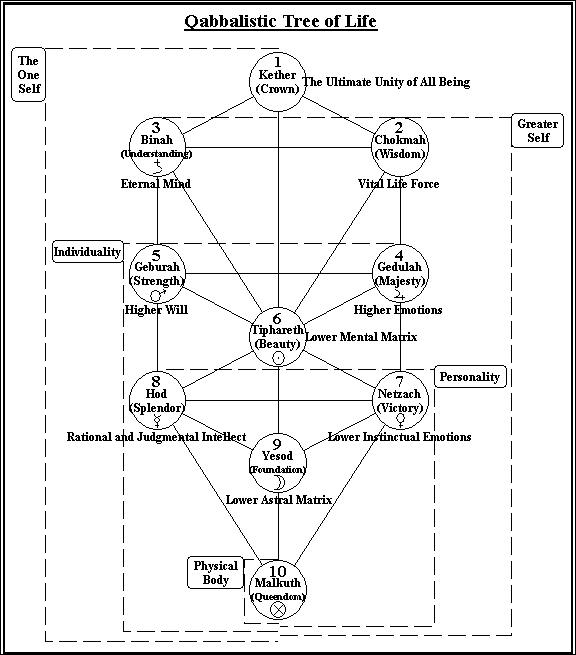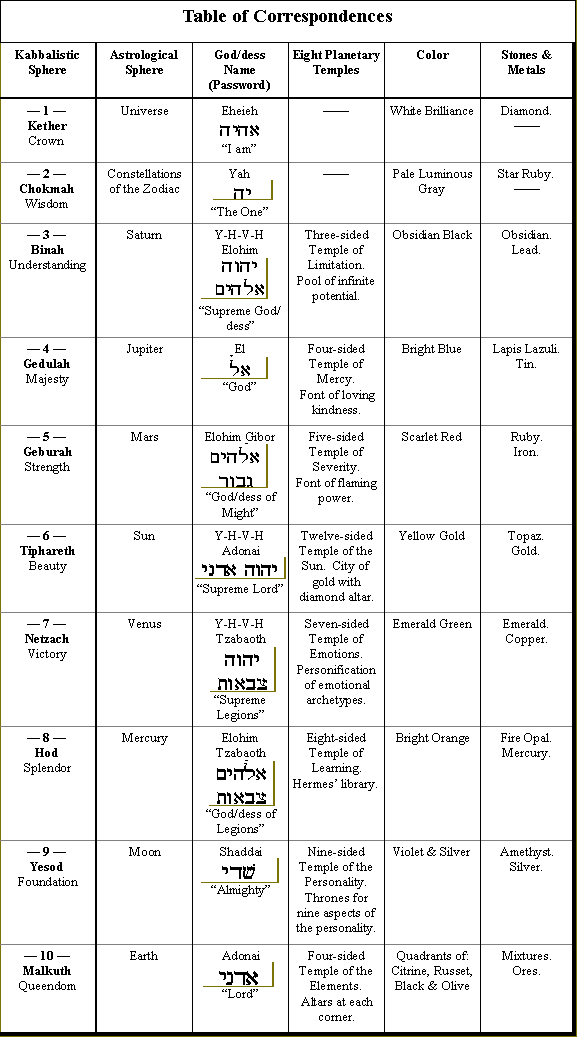|
INTRODUCTION
That ancient challenge, "know thyself", is the primary call to arms for those seeking self-realization or initiation into the Mysteries. The great error many make is in assuming that self-knowledge is just an internal thing. But quite the contrary is true, for the 'self' we are trying to discover is ultimately an infinite, all-encompassing, universal being. To truly "know thyself" is to know that all is Self.
It is for this reason that a path of initiation seeks to correlate the inner, personal world of the psyche, with the outer, physical world. These all-too-often disparate realms are woven together by taking full advantage of their commonalities in structure. With the tools of analogy and symbolism in hand, the initiate artfully traces the lines of causality that naturally exist between what is experienced internally and what is experienced externally.
The initiate achieves this by pursuing self-examination concurrent with a disciplined study of the external universe. Each is pursued with the other in mind. In other words, universal principles are studied and applied to the work of self-examination. Likewise, personal principles, learned from self-examination, are applied to the work of understanding the external world. Joined in this way, the outer illumines the inner and vise versa.
A classic example is the work with the Four Elements outlined by Franz Bardon in his excellent book, Initiation Into Hermetics. Here, the Elements are explored and employed in two ways. The first is external and involves certain meditational practices which lead to an experiential understanding of the Elements as universal forces. The second, concurrent way is internal, wherein the universal-Elements are used as an analytic structure, a template which guides the examination of the inner personality-self. This second usage correlates the universal-Elements with the personal-Elements at a very practical, experiential level.
Throughout history, the essential process of self-realization has been draped over a vast number of different philosophical structures, each one symbolizing a specific understanding of the universe. It is more the presence of structure, than the nature of the specific structure chosen, that determines success. Thus a Catholic is just as likely to achieve Self-realization as is a Buddhist or a Wiccan or a Qabbalist or an Aboriginal Shaman, to name just a small few of the many options manifest throughout the world.
This is not to say that the type of structure is unimportant. For without a doubt, the philosophical specifics of any given structure will influence the details of the process of self-realization. The point is that a structure can either limit your experience or open it to expansion; depending however, not so much upon the structure itself, as upon how you approach that structure and what you do with it.
The eight meditations which follow serve as very practical introductions to the specific structure of Western Hermetic Qabbalah. Each of the meditations is an experience that illumines both the inner and outer significance of the realms explored. Here, the essentially internal process of meditation is focused upon factors which directly concern the meditator's external life circumstance.
The eight astra-mental Temples outlined in the series are designed to become lifelong tools. Each one has practical applications for both the initiate's internal and external work. Once introduced to the Temples, the initiate is free to return to them at any time and pursue further, more detailed work. Thus the astra-mental Temples themselves, as well as the initiate's relationship with them, evolve over time. With repeated usage, their inherent structure aligns the initiate's inner and outer worlds, and establishes the solid, integral foundation which serves as the initiate's springboard to continual self-expansion.
Project Outline--
The 8 Temples Meditation Project evolved out of an earlier project in which a small group of us experimented with meeting regularly at an astra-mental locale. That original experiment ran for two years (Nov.'95 through Dec.'97), during which time we learned many valuable, and ultimately practical, lessons about the astra-mental realm itself and about meeting there. [For more details, please refer to my article Beneath an Astral Moon.]
As the experimental phase of our work together came to a conclusion, I considered instigating a new project, one based not upon learning new lessons, but upon proving out and making good use of the lessons we had already learned.
Around that same point in time, two different friends spoke of their desire to learn more about the Qabbalistic Tree of Life and about the practical meanings of the planetary symbols. So, I designed the Project to incorporate both the aforementioned lessons about astra-mental time-space, and my own knowledge of practical Qabbalah and astrology.
The 8 Temples Meditation Project ran for eight months -- starting with the late-December, 1997 new moon and ending with the early-August, 1998 full moon. Around the day of the new moon each of the participants received a packet of information in the mail. These "New Moon Packets" each contained an explanatory introduction and an outline of the upcoming meditation.
The meditations were scheduled on or near each month's full moon, so all the participants had two weeks to study the written material. During those two weeks, I constructed the astra-mental Temples and then I conducted the meditation ritual as scheduled.
Within a week after the meditation, each of the participants submitted a report detailing their experiences. Copies of these reports were then forwarded to the participants in the following New Moon Packet. This particular practice allowed for two things: 1) It allowed each participant to see what others had experienced. 2) It allowed me to gauge the effectiveness of what I was doing, as I was doing it. Each month I analyzed the reports in receipt and used that information to fine-tune the upcoming meditation.
The Project followed a standard "Path of Return" approach to the Qabbalistic Tree of Life. The meditations began with sphere 10, Malkuth/Earth, and worked up the Tree to sphere 3, Binah/Saturn. Each meditation built upon the experiences of the one preceding it, so there is a clear continuity throughout the series.
One desire I held for the Project was that it would achieve a balance between "script" and "spontaneity". On the one hand, the earlier group work had taught me how powerful a focusing influence a predetermined structure can have upon an astra-mental meeting. But on the other hand was the equally clear lesson that only spontaneity can raise such a structure from the level of "theatrical delusion" to the realm of true magic. Therefore, each of the meditations includes a period of un-scripted, self-directed time, during which the participant interacts spontaneously with the environment at hand.
I am a magician. For me, this Project is a work of magic. After finalizing their design, each of these eight Temples were ritually constructed out of the astra-mental substance, using all the various magics I am familiar with. Their individual construction took anywhere from an hour to several months to complete, varying radically from Temple to Temple.
Not only the Temples themselves had to be constructed, but also the connections between the Temples had to be established. Furthermore, the Temples had to be truly joined with the realms that they symbolize.
I used a specific structure in establishing the connections between the Temples. For this, I designed a specific sequence of visualizations, actions and spoken words, that unlocks the connections between specific realms. By following this induction sequence, one accesses the chosen Temple. The first time that one pursues the induction, one is led directly to an experience of the introductory meditation ritual.
This brings me to the issue of time. Astra-mental space-time is not quite like physical space-time. It is a much more fluid, malleable thing.
Physical time is a measurable constant -- we can clock its passage. Astra-mental time however, is not constant in the same way physical time is. For example, the passage of one hour's physical time can be experienced anywhere between the poles of in-the-blink-of-an-eye and ages-and-ages. This is the astra-mental component of time -- an immeasurable, experiential thing defined not by a clock's ticking, but by the quality and quantity of one's personal attention and intention.
It is possible to so enhance the astra-mental aspects of a specific moment of physical time (working through the now-ness of the present-moment) as to result in its preservation. What is preserved is that moment's quality of real-time, present-moment now-ness -- a quality that is generally lost as we move further away in time from the incidents contained within any given past-moment of time-space. When applied to a span of time (a connected series of present-moments) this process of enhancement and preservation is called "encapsulation".
Yes, I know, that's a complex string of concepts I have just strung for you! To simplify: I have so designed these meditations that the real-time enactment of these rituals has been preserved astra-mentally. Since I encapsulated the astra-mental component of each of the Project's hour-long meditation rituals, by simply following the induction sequence of visualizations, etc., you will be led directly to the encapsulated hour itself and actually participate in the outlined ritual as it was originally performed.
This was born out in two different ways during the Project. The first was that we perceived a nearly countless swarm of individuals attending our meditation rituals from future points in time-space. These were clearly folks, like yourself, who were reading these words and pursuing these meditations from within a present-moment that had yet to occur when the meditation rituals themselves were performed. Nonetheless, your presences were all accounted for and engaged during the real-time enactment of those rituals. In several instances these "future-folk" played important roles in the shared, group experience!
The second evidence that the encapsulation of each meditation was successful, is the experience of those participants who, for one reason or another, were unable to participate on the scheduled night and ended up pursuing the meditation a few days or a week later. Without fail, they were able to access a real-time experience of the original meditation ritual.
The eight Temple meditations which follow are meant only as introductions to these astra-mental realms. They merely acquaint one with the terrain and with the tools available for working there. In light of this fact, each of the meditation outlines is followed by suggestions for future, solitary work.
The structure of these meditations is such that once introduced, you are free to re-visit the Temples at any time you choose. An analysis of the Project reports reveals that for each of the original participants, the eight Temples have become handy tools to which they return frequently in pursuit of their ongoing, spontaneous inner work. I pray that you too will find them of lasting value.
Overview of Symbols--
The Qabbalistic Tree of Life originated over 2,000 years ago (some say over 6,000 years ago) in the context of the Jewish mystical tradition, and has been a core part of the Western Hermetic tradition for at least 500 years. Today, there are many variations of Qabbalistic symbolism in use, ranging from the strictly Jewish Kabbalah, to the strictly Christian Cabala.
The variation employed for this series of eight meditations will be a fairly simple Western Hermetic approach -- heavy on the Hebrew and Pagan, and light on the Christian, as is my way. However, the emphasis here will be less upon magic per se, and more upon spiritual growth.
First step is to familiarize yourself with the following diagram and table of correspondences. You needn't memorize them, just acquaint yourself with them.
|
|



